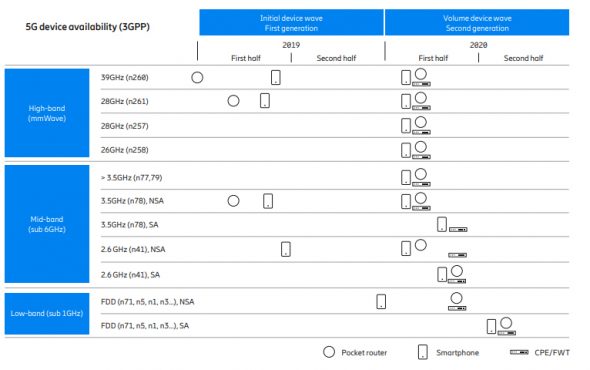 The latest Ericsson Mobility Report, released today, offers a wealth of information about the state of mobile networks. 5G is expected to gain scale in 2020, enabled in large part by expanded 5G device availability, the authors note, and they see 5G being quickly adopted in North America, where they see 74% of mobile broadband subscriptions using 5G by 2025.
The latest Ericsson Mobility Report, released today, offers a wealth of information about the state of mobile networks. 5G is expected to gain scale in 2020, enabled in large part by expanded 5G device availability, the authors note, and they see 5G being quickly adopted in North America, where they see 74% of mobile broadband subscriptions using 5G by 2025.
5G Device Availability
Global 5G device shipments will climb from 13 million in 2019 to 160 million in 2020, according to Ericsson. By next year, all major vendors will have released a 5G-capable device. And while initial 5G devices have been quite costly, some vendors are expected to have mid-tier 5G devices available in 2020.
Initial 5G devices operated only in a few spectrum bands, with millimeter wave devices launching first, followed by devices operating in the 3.5 GHz and 2.6 GHz bands – a reality that drove the first carriers deploying 5G to use millimeter wave spectrum.
Devices operating in the 3.5 GHz and 2.6 GHz bands also had limitations. They operated only in non-standalone mode, meaning they were designed to be deployed on infrastructure that also supported LTE, with LTE being used to support activities such as communicating with cell towers and servers.
By the first half of 2020, however, Ericsson expects to see devices available in more bands and supporting standalone and non-standalone mode. Standalone mode enables a company to build 5G networks without LTE underpinnings – a strategy that could be more economical and that at least one U.S. service provider, Dish Network, plans to use.

VoLTE and IoT
Two other technologies that are seeing strong growth are voice over LTE (VoLTE) and IoT technologies, including NB-IoT and Cat-M.
According to Ericsson, VoLTE will underpin 2.1 billion subscriptions globally in 2019, rising to 6.4 billion in 2025, with the majority being in the Asia Pacific region. More than 2500 VoLTE-enabled device models are now in the market globally, according to Ericsson. Of those, 165 use a high-definition voice codec that offers enhanced reliability and audio quality using what is known as “enhanced voice services,” or EVS. Globally, more than 20 service providers support EVS.
Regarding IoT, the authors of the Ericsson report counted 114 service providers globally that have launched one or both of the key cellular IoT technologies – NB-IoT and LTE-M. Of these, 25% have launched both options.


